
Personal luxury car is a North American car classification describing somewhat sporty, sophisticated coupes that emphasized comfort over performance. The North American manufacturers most often combined engineering, design, and marketing to develop upscale, distinctive "platform sharing" models that became highly profitable.

The Ford Mondeo is a large family car manufactured by Ford since 1993. The first Ford declared a "world car", the Mondeo was intended to consolidate several Ford model lines worldwide. The Mondeo nameplate is derived from Latin mundus, meaning "world".

The CVH engine was introduced by Ford in 1980 in the third generation European Ford Escort and for the 1981 North American Escort. It was later used in the Ford Sierra as well as the second generation Ford Fiesta and from 1983 it was used in the Ford Orion. Engines were built in the Dearborn Engine Plant for the North American market, and in Ford's then-new engine plant in Bridgend in Wales for the European market.

The Lincoln Continental is a series of mid-sized and full-sized luxury cars produced by Lincoln, a division of the American automaker Ford Motor Company. The model line was introduced following the construction of a personal vehicle for Edsel Ford, who commissioned a coachbuilt 1939 Lincoln-Zephyr convertible, developed as a vacation vehicle to attract potential Lincoln buyers. In what would give the model line its name, the exterior was given European "continental" styling elements, including a rear-mounted spare tire.

The Ford Verona and Volkswagen Apollo are a pair of small family cars that were manufactured in Brazil by Autolatina, a joint venture between Brazilian subsidiaries of Ford and Volkswagen. The Verona was produced from 1989 to 1992 and from 1993 to 1996, initially as a direct replacement for the ageing Ford Del Rey.
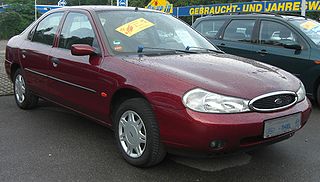
The Ford CDW27 platform is a former automobile platform produced by Ford in worldwide markets from 1993 to 2007. Used for midsize cars, the CDW27 architecture was a "world car", becoming the second Ford world car.
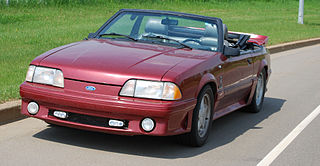
The Ford Fox platform is an automobile platform that was used by Ford Motor Company. Introduced for compact sedans in the 1978 model year, the Fox architecture was utilized for a wide variety of configurations for Ford and Lincoln-Mercury vehicles. In its original form, the platform was used until 1993, with a substantial redesign of the Ford Mustang extending its life through the 2004 model year. With the exception of the Panther platform, the Fox platform is the longest-produced vehicle architecture by Ford Motor Company.
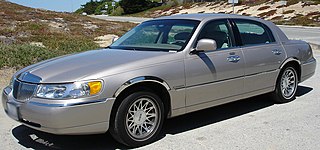
The Ford Panther platform is an automobile platform that was used by Ford Motor Company from the 1979 to 2012 model years. Following the downsizing of the General Motors B-bodies and C-bodies by two years, the Panther platform marked the end of production of sedans unencumbered by downsizing. Originally slated for discontinuation during the early 1980s, the Panther architecture was used for 33 model years, the longest-produced platform in North American automotive history.
The Mazda B platform is an automobile platform for compact cars. It has been used by a number of vehicles from Mazda and Ford Motor Company in Japan and abroad.

The Ford Tempo and its twin, the Mercury Topaz, are compact cars that were produced by the Ford Motor Company for model years 1984 to 1994. They were downsized successors to the boxy Ford Fairmont and Mercury Zephyr twins. The Tempo and Topaz were part of a rejuvenation plan by Ford to offer more environmentally friendly, fuel efficient, and more modern styled models to compete with the European and Japanese imports. While the car sold well, its innovation and aerodynamic design paved the way for the even more groundbreaking Ford Taurus. The Tempo and Topaz were replaced for 1995 by the "world car" platform sold in North America as the Ford Contour and Mercury Mystique.
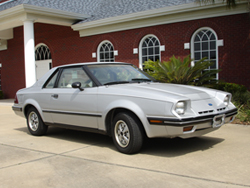
The Ford EXP is a sports compact coupe that was produced and sold by Ford Motor Company in North America from the 1982 to 1988 model years. The first two-seat Ford since the 1957 Thunderbird, the EXP made its debut at the 1981 Chicago Auto Show. Sharing the dashboard, wheelbase, suspension, and powertrain with the Ford Escort, the EXP was longer, lower, and more aerodynamic than its five-seat counterpart.

The Ford Escort is a small family car which was manufactured by Ford Europe from 1968 to 2004. The Ford Escort name was also applied to several different small cars produced in North America by Ford between 1981 and 2004.
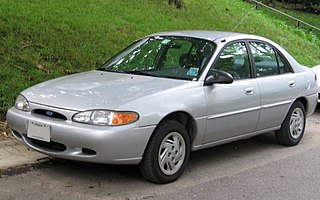
The North American variant of the Ford Escort is a small family/compact car introduced by Ford in 1980 for the 1981 model year. Sharing its name with the third-generation European Ford Escort, the model line is the first front-wheel drive Ford developed and sold in North America. The direct successor of the Ford Pinto, as the smallest Ford car in North America, the Escort largely replaced the European-imported Ford Fiesta.
Michigan Assembly Plant, formerly known as Michigan Truck Plant, is a Ford Motor Company assembly plant in Wayne, Michigan. The plant employs 1,200, comprises three main buildings with 2,900,000 sq ft (270,000 m2) of factory floor space and is located adjacent to Wayne Stamping & Assembly. The plant was built in 1957 and has seen many expansions and upgrades. The plant manufactured the third generation, North American Ford Focus from December 14, 2010 until May 4th, 2018.
The FLC-"Fluid Link Converter"- ATX was a 3-speed hydraulic automatic transaxle produced by Ford Motor Company from 1981 through 1994. It was Ford's first automatic transmission developed for front wheel drive and transverse engine location. Used in the company's four-cylinder-powered cars ranging from the Escort to the Taurus, the transaxle had a lockup torque converter, but no overdrive. It was controlled by a throttle or "kickdown" cable, the speedometer used an air powered cable, and had no computer controls.
The Ford MTX transmission is a 4 or 5-speed manual transaxle used in some of Ford's front-wheel-drive North American passenger cars.
The Continental Mark VI is a full-size luxury car that was produced by Ford Motor Company and marketed by its Lincoln division from 1980 to 1983. The fifth generation of the Mark series, the Continental Mark VI was the first ground-up revision of the model line since 1972, and the first generation to undergo downsizing. In another major change, the Mark VI shifted model commonality from the Ford Thunderbird to the Lincoln Continental. As the flagship line of Ford Motor Company, the Mark VI was fitted with distinct features to distinguish itself from the Lincoln Town Car, including the return of Designer Edition trims.

St. Thomas Assembly was an automobile plant located in Southwold, Ontario, Canada close to the Talbotville community and to the nearby city of St. Thomas. The 2,600,000 sq ft (240,000 m2) facility, situated on a 635 acres (2.57 km2) site, opened in 1967, building the Ford Falcon. Flexible fuel vehicles (FFV) capable of operating on ethanol fuel were manufactured there during the later years of the assembly plant. Ford's plans for sustainability and reduction of fossil fuel consumption relied on the St. Thomas Plant and its Lincoln Town Car vehicles for years. It also produced the final Mercury vehicle, a Mercury Grand Marquis, after Ford decided to discontinue the Mercury brand after the 2011 model year.

The North American version of the Ford Granada is a range of sedans that was manufactured and marketed by Ford. Introduced for the 1975 model year as the intended successor as the Ford Maverick, the Granada was sold through the 1982 model year across two generations. Sharing its name with the flagship sedan of Ford of Europe, the Granada was slotted above the Maverick as a luxury compact vehicle, expanding the segment in the United States.

The Ford Mondeo I is a mid-size car that was produced by Ford, beginning on 23 November 1992, with sales beginning on 22 March 1993. It is also known as the Mk I Mondeo; the 1996 facelift versions are usually designated Mk II. Available as a four-door saloon, a five-door hatchback, and a five-door estate, all models for the European market were produced at Ford's plant in the Belgian city of Genk. In December 1992, Autocar published a section on the Mondeo, and how it would conquer rivals.















